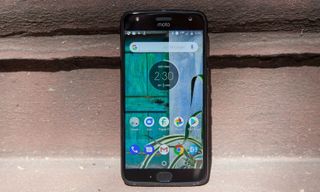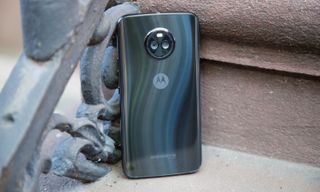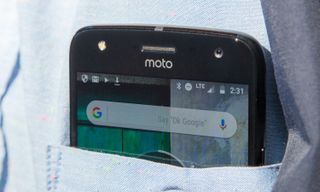Moto X4 Android One Review: A Cheaper Entry to Project Fi
The Moto X4 Android One is a great lower-cost entry point for Google's wireless service, but it makes compromises other phones don't.
Why you can trust Tom's Guide

Before the modular Moto Z, there was the Moto X — Motorola's flagship smartphone that combined a completely customizable design with high-end internals and stock Android at its best. It's been two years since we've seen a new phone in the range, and now the name is making a return in the form of the Moto X4.
Interestingly, the latest X shares very little with its predecessors. Whereas those phones were true flagships with the best hardware available at the time, the Moto X4 is now aimed at midrange buyers. Starting at $399, it costs less than half as much as Samsung's Galaxy S8 Plus.
Like the rest of the phones in Motorola's roster, the Moto X4 is reasonably priced for what it offers, particularly if you want Google's Project Fi wireless service. But when compared to value powerhouses like the OnePlus 5, the X4 will leave you wanting more.
Configurations and carrier support
The U.S. version of the Moto X4 has 32GB of storage and 3GB of RAM. The standard version of the phone is available for preorder now and will hit retailers on Oct. 26. Via its Prime Exclusives program, Amazon will offer a discounted version of the X4 in exchange for lock-screen ads.
In gaining Project Fi compatibility, the Android One version of the Moto X4 loses a few features — notably, Amazon Alexa integration and some of Motorola's convenient gesture controls.

However, there's yet another version of the phone, called the Moto X4 Android One, and that's the model we've tested here. (We plan to review the standard X4 once we get our hands on that version.)
The Android One variant is almost the same as the standard model, but it has a key difference: support for Google's Project Fi wireless network. Project Fi operates on a prepaid system, similar to the way Cricket Wireless or Metro PCS work, though users pay only for the data they use.
MORE: Best Cheap Unlocked Smartphones
In gaining Project Fi compatibility, the Android One version of the Moto X4 also loses a few features — notably, Amazon Alexa integration and some of Motorola's convenient gesture controls.
Moto X4 Android One Specs
| Price | $399 |
| OS | Android 7.1.1 Nougat |
| Screen Size (resolution) | 5.2 inches (1920 x 1080) |
| Size | 5.84 x 2.89 x 0.31 inches |
| Weight | 5.75 ounces |
| CPU | Qualcomm Snapdragon 630 |
| RAM | 3GB |
| Storage | 32GB |
| MicroSD Slot? | Yes (up to 2TB) |
| Rear Camera | 12-MP main, 8-MP wide-angle |
| Front Camera | 16 MP |
| Battery Life (Hrs:Mins) | 11:41 |
Design: Haven't we been here before?
If you've seen any of Motorola's 2017 handsets, you've pretty much seen the Moto X4. When you compare the X4 side by side with the recently released G5S Plus and range-topping Z2 Force, it's remarkably difficult to tell the three phones apart. They all have the same general shape, chunky bezels, curved glass and oval-shaped fingerprint scanner.

It's only when you turn the phones over that you begin to pick up on the subtle differences. The back of the Moto X4 is shrouded in ultrashiny glass, which tapers off at the edges to smoothly meet the matte aluminum frame. It's a good look and, fortunately, instills the phone with a premium feel despite the aged design.

Motorola has once again packaged both rear camera lenses into a massive circular housing, and it simply looks gaudy.
In spite of those details, you can't miss the massive dual-camera module in the center of the phone's backside. Motorola has once again packaged both lenses into a circular housing, and it looks gaudy.

While it doesn't stick out quite as prominently as the one on the G5S Plus or the Z2 Force, the camera module is still larger than it needs to be. As much as I appreciate that Motorola strove to make its devices more distinctive, this isn't the way to do it.
Display: Great for an LCD
Unlike many of its more expensive counterparts, the Moto X4 does not boast an OLED screen. Rather, it features a 5.2-inch full-HD LCD panel. That's perfectly fine for a midrange product, but you shouldn't expect to be blown away.
When I watched the Black Panther trailer on YouTube, the X4 displayed a slightly cool tint and seemed a little washed out overall. It's nothing particularly unusual compared to other LCD screens, but a second viewing on the OnePlus 5's OLED panel reminded me what I was missing. The Moto X4's contrast simply can't measure up.

At least the X4's screen is very bright. Our light meter showed 513 nits from the Moto X4's display, handily beating the 413-nit smartphone average. It reproduced 128.0 percent of the sRGB color spectrum — a wide swath for an LCD display. Color accuracy was solid as well, with the Moto X4 managing a Delta E rating of 0.62 (numbers closer to 0 are better). Moto's own G5S Plus delivered a superior 0.29 result, despite costing nearly $200 less.
Camera: Quantity doesn't equal quality
In terms of smartphone design, 2017 will probably go down as the year dual cameras became simultaneously ubiquitous and almost worthless. And we have devices like the Moto X4 to thank for that.
Of course, some handsets use their second cameras to great effect, as anyone who's enjoyed the privilege of shooting with an iPhone 8 Plus or Samsung Galaxy Note 8 can attest. Unfortunately, the technology simply hasn't translated well to cheaper devices yet. Unless you're spending good money, a plurality of lenses typically means improperly focused depth-of-field shots or blurry, smeary wide-angle landscapes.

The Moto X4 is guilty on both counts. The phone's primary sensor is rated at 12 megapixels, with an f/2.0 aperture. The secondary, 8-megapixel camera has a wide-angle lens with a 120-degree field of view. Neither produces particularly impressive results.
Compare the Motorola's portrait-style efforts above to shots from the OnePlus 5, and it's immediately clear that the X4 cannot adequately identify the boundaries of the figure in the foreground. This results in oversoftened edges that bleed into regions that should remain in focus, completely betraying the authenticity of the effect.
Still, the second lens on the X4 has one advantage over the OnePlus 5: It can capture ever-expansive wide-angle shots most phones can't. This is probably the greatest strength of the Moto X4's photography, though images taken with this sensor lack the clarity and crispness of those taken using the primary lens.
The primary lens is nearly as middling. These shots taken at Brooklyn's Navy Yard utilize HDR mode on both phones, but you wouldn't know it by looking at the Moto X4's dim exposure. The OnePlus 5's attempt features greater detail overall, and retains much more visibility in the darker sections, which is particularly evident in the text on the walls on the left and the shadows cast on the building straight ahead. Not to mention, the OnePlus 5's shutter acted much more quickly every time we pressed the button.
The same story goes for the 16-MP front-facing camera. Notice how the Moto X4 completely misses the texture on the interior of my jacket's collar.
The phone fails again in its grainy execution of the low-light scene below. While the Moto X4's white balance is preferable, the OnePlus 5's version is far less grainy.
Performance: Strong, but not stunning
The Moto X4 is decently fast, and Qualcomm's Snapdragon 630 processor, paired with 3GB of RAM, is the reason why. There were no hiccups as I played Madden NFL Mobile, explored the world of Epic Citadel or streamed Bluetooth audio while navigating Google Maps.
There's little use in comparing the Moto X4 to the OnePlus 5 in this category — the OnePlus 5 clearly smokes it, thanks to its much faster Snapdragon 835 processor and twice the RAM. That's the same chip featured in such high-end offerings as the Galaxy S8, Google Pixel 2 and Essential Phone.
A fairer opponent would actually be one of Motorola's budget offerings. The recently reviewed $279 G5S Plus has a slightly less powerful Snapdragon 625 chipset, and in testing the Moto X4 barely outpaced it.
MORE: Best Smartphones on the Market Now
The Moto X4 turned in a score of 4,122 on Geekbench 4, which measures overall system performance. That beats the G5S Plus' score of 3,746. The X4 also edged out the G5S Plus in terms of graphics capabilities, delivering a score of 16,815 on 3DMark's Ice Storm Unlimited benchmark, compared with 13,805 from the G5S Plus.
Those are modest gains, but the Moto X4 claims a number of improvements outside of sheer specs muscle. It has near-field communication for Android Pay, as well as IP68 water resistance and 32GB of onboard storage as standard. As with the G5S Plus, there's a microSD slot, which is compatible with memory cards up to 2TB.
Battery: Long and quick to charge
The Moto X4 makes its fair share of compromises, but battery life isn't one of them. The phone clocked 11 hours and 41 minutes on our Tom's Guide Battery Test, which, in this case, was conducted by endlessly loading web pages on Project Fi's cobbled-together LTE network.

Project Fi combines T-Mobile, Sprint and U.S. Cellular's towers for better coverage than any one of those networks can deliver on its alone. The Moto X4 Android One edition supports Project Fi out of the box, but it isn't locked to it — for example, you can still take the phone to a different network. When we conducted the same battery test with an AT&T SIM card inside, the runtime was nearly 2 hours shorter — 9 hours and 50 minutes.
MORE: Smartphones with the Longest Battery Life
Between Project Fi's power-friendly service and the 3,000-mAh battery inside, the Moto X4 delivers great longevity while being quick to charge. Simply plug the phone in with the provided TurboPower adapter for 15 minutes, and you'll have 6 hours of juice.
Software: Lacking some useful features
The Moto X4 is an Android One device, and normally, that would mean it runs the stock configuration of Google's operating system. The Moto X4 is slightly different, though. There's Android 7.1.1 Nougat on board — Motorola says the phone will get an Oreo update before the end of 2017 — but it's largely the same experience you'd encounter on any of Motorola's non-Android One phones.

That's not necessarily a problem, considering Motorola's interface tweaks tend to be light, simple and elegant. But there are two features missing from the Android One version that we would have liked to see make the jump.
The first is One Button Nav. Just like the Moto E4 Plus, G5 Plus and G5S Plus, the X4 typically includes an app called Moto Actions, which contains handy gestures for improving overall usability. In the X4, this includes Motorola's usual roster of shortcuts, like three-finger tap for screenshots, chop twice for the flashlight and twist twice for the camera.
Between Project Fi's power-friendly service and the 3,000-mAh battery inside, the Moto X4 delivers great longevity while being quick to charge.
Yet the Android One variant of the Moto X4 is missing One Button Nav, which utilizes the fingerprint sensor in place of the standard Android navigation bar. With One Button Nav on, the sensor becomes the home button, swiping back replaces the dedicated back button, and swiping right brings up the recent-apps list. It's convenient once you get used to it; not to mention, it frees up a decent chunk of screen space normally unavailable to apps.
MORE: 10 Reasons Android Beats the iPhone
Also absent in the Android One version is integration with Amazon's Alexa. The Moto X4 is the first phone to launch with Alexa since the HTC U11, and it's no surprise that Google axed it from the Android One version of the phone. But many people rely on Alexa as their digital assistant of choice, and they might be dismayed at its absence. Fortunately, Google Assistant is still ready at your beck and call, and it's no less helpful a companion. (And if you really value Alexa integration over Project Fi compatibility, you could always opt for the standard edition of the phone at no difference in price.)
Bottom Line
The Moto X4 is commendable for a midrange mobile phone, but it's also conflicted. In some ways, it feels like a full-priced flagship. The metal-and-glass craftsmanship is satisfying, if not seductive. The battery life exceeds what you get from many phones that cost twice as much. And the inclusion of water resistance and NFC places it a caliber above budget competitors.
And yet despite all that, the X4 still can't compete with the benchmark of bargains, the OnePlus 5. For $80 more, OnePlus throws in a more vibrant display, a faster processor, sharper cameras and double the RAM. It’s simply an all around better phone that never leaves you wanting for more.
Alternatively, you could spend $120 less for the G5S Plus. The G5S Plus matches the Moto X4 in nearly every dimension, save for IP68 protection and tap-and-pay support. For its price, it's a much more compelling value.
The Moto X4, on the other hand, is neither here nor there. The Android One version certainly makes a case for itself as the first low-cost Project Fi phone — or at least low-cost compared to Google's Pixel devices. If you're interested in Google's service, there's nothing else like it on the market. But as supremely well-rounded as the Moto X4 is, you can still do better, particularly if you're not partial to a specific wireless carrier.
Credit: Shuan Lucas/Tom's Guide
Sign up to get the BEST of Tom’s Guide direct to your inbox.
Upgrade your life with a daily dose of the biggest tech news, lifestyle hacks and our curated analysis. Be the first to know about cutting-edge gadgets and the hottest deals.
Adam Ismail is a staff writer at Jalopnik and previously worked on Tom's Guide covering smartphones, car tech and gaming. His love for all things mobile began with the original Motorola Droid; since then he’s owned a variety of Android and iOS-powered handsets, refusing to stay loyal to one platform. His work has also appeared on Digital Trends and GTPlanet. When he’s not fiddling with the latest devices, he’s at an indie pop show, recording a podcast or playing Sega Dreamcast.
